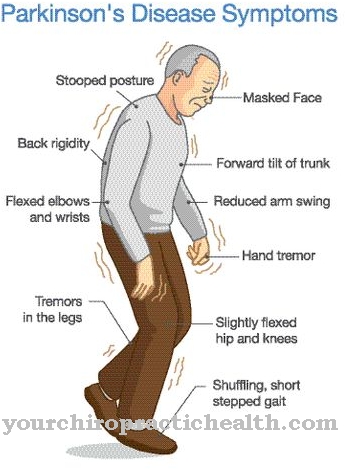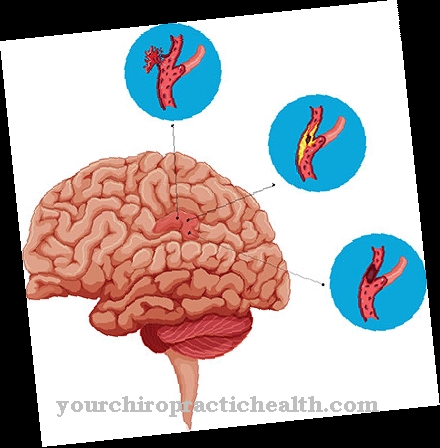As arrhythmogenic right ventricular cardiomyopathy is called a heart disease.
What is arrhythmogenic right ventricular cardiomyopathy?

© bilderzwerg - stock.adobe.com
In arrhythmogenic right ventricular cardiomyopathy (ARVCM) is a heart disease that is already congenital. In earlier times it was also called Arrythmogenic right ventricular dysplasia (ARVD). It is one of the cardiomyopathies in which the structure of the heart muscle tissue is damaged.
This in turn causes it to lose performance. Cardiomyopathy is noticeable through heart failure. In extreme cases, the affected person can even experience sudden cardiac death. Arrhythmogenic right ventricular cardiomyopathy usually occurs between the ages of 15 and 40.
Older people over 60 years of age are less likely to be affected. Men are more likely to suffer from ARVCM than women. In addition, they also have a more intense course of heart disease. Arrhythmogenic right ventricular cardiomyopathy is not uncommon in athletes and is considered to be the cause of sudden cardiac death in some cases.
There are major regional differences in the frequency of ARVCM. In the United States of America, with an incidence of 1: 100,000, it occurs significantly less than in Europe, where it affects one in 10,000 people.
Northern Italy and the Greek island of Naxos are particularly affected by cases of arrhythmogenic right ventricular cardiomyopathy. There, the ARVCM occurs in 1 in 1,000 people. In Italy, doctors even classify cardiomyopathy as the most common cause of death in young athletes.
causes
The exact causes for the development of arrhythmogenic right ventricular cardiomyopathy are so far unknown. It is clear, however, that it occurs in families, which is why many doctors suspect genetic factors to be the cause of the heart disease. So far, three loci have been found between chromosomes 14 and 1.
However, several factors are believed to be responsible for the extent and course of ARVCM. During arrhythmogenic right ventricular cardiomyopathy, fatty deposits and connective tissue accumulate within the muscle tissue of the right ventricle. As a result, the contractions of the ventricular muscles are disturbed. Sometimes this can lead to a complete loss of functions.
There is a disturbance in the electrical conduction of the heart muscle, the spread of which occurs from the sinus muscle via the muscles of the right heart. This threatens severe cardiac arrhythmias including life-threatening arrhythmias. The patient may die suddenly due to ventricular fibrillation.
Symptoms, ailments & signs
Arrhythmogenic right ventricular cardiomyopathy becomes noticeable through cardiac arrhythmias such as palpitations or palpitations, which are perceived as very unpleasant. Some patients also suffer from impaired consciousness and fainting spells.
If the ARVCM takes a severe course, there are signs of right heart failure. These include edema (water retention) in the arms and legs, congested neck veins, enlarged liver, and blue lips. In the worst case, there is a risk of sudden cardiac death due to acute heart failure when exercising. The person concerned does not notice any complaints in advance.
Diagnosis & course
In order to be able to diagnose arrhythmogenic right ventricular cardiomyopathy, extensive examinations are required. Since the heart disease often occurs several times in families, a family history is helpful. The EKG is one of the most important examination procedures. Characteristic changes can often be determined in a resting ECG.
Cardiac arrhythmias can also be determined using a long-term ECG or a stress ECG. In competitive athletes, a diagnosis is possible through a screening examination even without symptoms. Echocardiography is used to assess the performance of the heart.
If there are clear suspicions, a cardiac catheter examination is carried out. The doctor measures the pressure in the heart, which changes due to the ARVCM. In some patients, arrhythmogenic right ventricular cardiomyopathy is detected by direct detection of fat or connective tissue deposits by taking a biopsy (tissue removal) of the heart muscle.
To obtain the tissue sample, the doctor pushes a catheter towards the heart through a large vein like in the groin. He then uses small forceps to take a small sample of the tissue. The myocardial biopsy is considered very safe and is one of the routine medical examinations.
Local anesthesia at the catheter entry point is usually sufficient. Investigating arrhythmogenic right ventricular cardiomyopathy typically requires four to five tissue samples.
It is not uncommon for ARVCM to take an unfavorable course. Sudden cardiac death occurs in around 70 percent without treatment. However, if the cardiac arrhythmias can be suppressed, life expectancy is hardly reduced.
Complications
In most cases, cardiomyopathy causes discomfort to the heart that can make everyday life difficult for the patient. Many suffer from severe palpitations or a racing heart. These complaints occur mainly during physical activity or sport and can therefore restrict the patient's movement and activity.
This reduces the quality of life. It is not uncommon for patients to lose consciousness and faint. This can lead to different injuries.The lack of oxygen also leads to blue lips and blue colored extremities. The liver also enlarges, which can lead to pain.
The legs and arms suffer from water retention and can swell. If the person concerned continues to burden the body, in the worst case scenario, death from acute heart failure can result. Often the symptoms only appear acute.
Cardiomyopathy is usually treated with the help of medication. A defibrillator is surgically used, which can save the patient's life in serious situations. The disease usually reduces life expectancy.
When should you go to the doctor?
Since this complaint is a disease of the heart, it must definitely be examined and treated by a doctor. If there is no treatment, this disease can, in the worst case, lead to the death of the person concerned. The patient should then see a doctor if the heart beats or faints. Other disorders of consciousness may indicate the condition and should be examined by a doctor.
In many cases, the skin turns blue due to the reduced supply of oxygen to the skin. Right heart failure can also point to this disease and must be investigated. Furthermore, those affected often suffer from permanent tiredness and fatigue.
A doctor must also be consulted with these complaints. However, acute emergencies should be treated directly in a hospital or through an emergency doctor. Usually this condition is treated by a cardiologist. An early diagnosis can prevent various complications and consequential damages.
Doctors & therapists in your area
Treatment & Therapy
Not every ARVCM patient needs special treatment if there are no symptoms. However, intensive sport and heavy physical activity must be avoided. If therapy for arrhythmogenic right ventricular cardiomyopathy is required, the patient is given drugs such as calcium channel blockers and beta blockers.
Calcium antagonists such as diltiazem and verapamil inhibit the influx of calcium into the cells, which in turn reduces the formation and spread of excitation. This will slow the patient's heartbeat. The calcium antagonists are class IV arrhythmics.
Beta-blockers such as propanolol and metoprolol are used against heart failure and high blood pressure. By blocking the beta receptors, they ensure that the excitability of the heart muscle is reduced, which results in a slower heartbeat. The beta blockers are class II arrhythmics. If there is a high risk of sudden cardiac death, the patient is given class I and III arrhythmics. A defibrillator is also implanted.
Outlook & forecast
Overall, the disease has an unfavorable prognosis. With current medical options, there is no treatment or therapy that will completely cure the condition.
The after-effects of the disease are treated very successfully through the administration of medication. However, after stopping the medication, symptoms return again. In severe cases, the patient is threatened with death. Nevertheless, numerous patients with arrhythmogenic right ventricular cardiomyopathy can live their lives unimpaired and without impairment. This depends on their lifestyle and the occurrence of possible symptoms.
There are patients who have been diagnosed with arrhythmogenic right ventricular cardiomyopathy and are still completely symptom-free. These patients are advised that in the future, if possible, they will hardly undertake any sporting or physically intensive tasks. Under these conditions, life is possible without further medical consultation. The average lifespan is not shortened for these people.
Most patients are young and middle adult and have symptoms. They are treated with medication based on their symptoms. They also have an increased risk of dying from sudden cardiac death. The risk of death increases as soon as the patient engages in heavy physical activities and thus underestimates his reduced level of performance.
prevention
There are no known preventive measures against arrhythmogenic right ventricular cardiomyopathy. The exact causes of the congenital heart disease remained unclear.
Aftercare
In any case, the person affected is primarily dependent on a medical examination and diagnosis so that there are no further complications or complaints. The earlier this disease is recognized and treated, the better the further course is usually because it cannot self-heal. Therefore, early diagnosis with early treatment is paramount in this disease.
In the worst case, if left untreated, the affected person can die. However, there are no special follow-up measures available to those affected. In general, a healthy lifestyle with a healthy diet also has a very positive effect on the further course of the disease. The treatment itself takes place with the help of medication.
These should always be taken regularly and as directed by a doctor, taking into account the correct dose. If in doubt or if anything is unclear, a doctor should be contacted. The person concerned should also check their blood pressure regularly and contact the doctor if high blood pressure occurs. Whether the disease will reduce life expectancy cannot be universally predicted.
You can do that yourself
The diagnosis “arrhythmogenic right ventricular cardiomyopathy” enables a life with few restrictions. In addition to adhering to the medication and regular cardiological check-ups, those affected should avoid heavy physical stress at work and in leisure time.
In particular, intensive competitive and endurance sports, such as basketball, handball, athletics, tennis or diving, lead to high stresses on the cardiovascular system and are unsuitable. Cycling or skiing should also be done carefully.
Suitable actuations are e.g. Golf, bowling, billiards or curling. In the case of children, educators, teachers or trainers should be informed about the disease. The load in physical education ideally remains in the aerobic range. The performance should not be overestimated even if there is no symptoms.
There are no general vacation or travel restrictions. However, some airlines do provide information for passengers with cardiovascular disease.
Those affected hardly have any other self-help options or specific preventive measures. The general rules of conduct for diseases of the cardiovascular system apply. Regular moderate exercise and a healthy diet rich in vitamins and minerals (especially with vitamin E, zinc and magnesium) help strengthen the heart muscles.
Stressful factors such as alcohol and nicotine are excluded. Flu infections and colds have a negative effect on the performance of the heart. Annual flu vaccinations make sense and are recommended by many medical professionals.

.jpg)

.jpg)





















.jpg)


